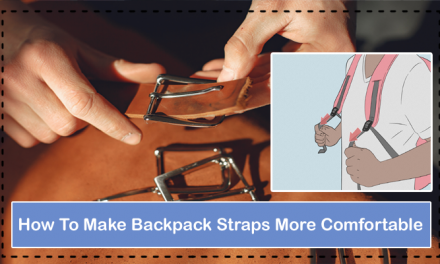Do you want your camera, binoculars, GPS, walkie-talkie, compass, and other essential accessories easily accessible during travelling? Or do you want to avoid the lower back pain you have whenever you are outdoors, experiencing hiking, etc.? you can have a privilege if you have the right choice of an outdoor-focused backpack. These can be a blessing to you during your trips. Is it irritating to travel with your hands carrying loads of your stuff, interrupting you to enjoy your trip?
Now, you don’t need to face the problems associated with luggage carrying if you look for an appropriate backpack. They are lightweight, has a lot of capacity, are waterproof, and are durable too. These bags assure you of the convenient organization of your stuff, letting your hands-free to enjoy your selfie session with your friends. Have you ever noticed the loops attached to your backpack? Have you ever tried to search for what are the circles on my backpack? No? don’t worry, this article will define many of them with their function.
Loops are critical to protecting the objects on the outside of the backpack. The bottom loops of a bag can help you secure your more oversized or bulky equipment. A trip is always enjoyable when you are not stressed about your luggage and its safety. Right? Many of the backpacks now are manufacturing with various loops and straps so that a user or traveller can experience much more conveniences and ensure the safety of their goods.
This article focusing on ‘what are the loops on my backpack for’ will be a comprehensive guide for you to understand the functions and various types of the loops attached to the backpack. After knowing the appropriate procedures and uses of these loops will help you correctly pack the goods that reduce the weight and help you secure them.
What Are the Loops on My Backpack for and Their Functions?
Let’s not go with the essential parts of the backpack, as these are the universal terms known by every one of us. Straps are also a necessary part of a backpack that holds the weight appropriately without letting you feel the burden. These straps include a hip belt, sternum strap and shoulder strap; all these help in non-slip grip and eliminates swaying back and forth movements.
Now, coming towards loops of a school, work, and commuting backpack re ideal for hiking, snow sports, mountain climbing, etc. Let’s have a deep look at the types of loops on the outside of a pack alongside their purpose so that you can get enough information of the most asked question, ‘what are the loops on my backpack.
Gear loops:
Outdoor backpacks with gear loops are ubiquitous in climbing, backpacking, and camping. Their initial purpose was to connect long objects like ice axes, axes, and walking sticks, but you can use them to attach everything from carbines to high-speed climbers. Equipment loops usually are made up of nylon straps that are sewed into the body of the backpack or hip belt to make a closed loop.
Gear loops, like fringe tabs, are sometimes used in stylish backpacks to give them an outdoor-inspired look.
Compression Straps:
Compression straps are usually found on the side of a backpack and are used to compress or extend the bag. Compression straps are commonly seen on gears designed to carry a lot of weight, such as hiking packs, travel packs, and some school bags since they allow the pack to be pressed closer to the back for better weight distribution and more comfortable carrying.
Elastic cord and tie out loops:
Small fabric loops put on the side or front of a backpack are known as tie loops. They’re just big enough to pass through a rubber or bungee cable, allowing you to make your external mount. Some backpacks have fastening loops, whereas others have an elastic string that has already been looped.
The elastic cord’s purpose is to secure anything too large or cumbersome to fit in the backpack, such as a backpack: B. a jacket, a bicycle helmet, or other accessories.
Lash tabs:
Lash tabs, commonly known as “pig balls,” are little leather patches found on the front of most backpacks. You can find attachment slots for Velcro straps, carabiners, and bicycle lights on these patches. An oblique square or diamond form is the most typical shape for an eyelash lip; however, they can come in various sizes and shapes. Have you ever noticed that your backpack has a case or a strap on the back? Carriage protection, luggage transport protection, and luggage handles are some of the names given to it, and its function is to allow you to attach your backpack to the handles of your suitcase when travelling. It’s a convenient feature that’s becoming more common in vacation and business backpacks. Its most distinguishing feature is two tiny slits that resemble a pig’s nose.
Fringe tabs were once only found on outdoor bags, but they are now commonly seen as decorations on anything from designer backpacks to schoolbook bags. For added durability or resistance to water, eyelash flaps are frequently made of rubber or plastic.
Hip belt loops:
On the outside, the hip strap of the backpack contains loops, braided straps, and pockets. You can secure almost any piece of equipment for them.
These give suitable attachments for climbing equipment such as fast pulls and carabiners, whether you’re prepared for a climbing or winter camping trip. When hiking or camping in chilly weather, they’re also a great place to connect your insulated bottle cages.
Bottom loading loops:
Loops at the bottom of large backpacks or those meant for more extended travels are included. When this can be a nice spot to hang your sleeping pad, wet tent, sleeping bag, or even hammock casing, any gear that dangles from them could cause you pain in your back because it swings between your legs or on the backside of your body when walking, in this way the movement can be slow down.
Instead of using the bottom loops, you should attach bulky items between the floating pockets or on their side and the top of the backpack if you’re going on an extended trip.
Daisy chains:
Daisy chains are often made of nylon and are sewed into the backpack to provide loops that allow carabiners, clips, and exterior pockets to be attached to the outside of the backpack for additional storage. Daisy chains are most found in outdoor backpacks with external tool mounts, although they can also be found as design embellishments in ordinary backpacks. Daisy chains are frequently seen on the front and sides of backpacks and the shoulder straps.
Trolley Sleeve:
Have you ever noticed that your backpack has a case or a strap on the back? Carriage protection, luggage transport protection, and luggage handles are some of the names given to it, and its function is to allow you to attach your backpack to the handles of your suitcase when travelling. It’s a convenient feature that’s becoming more common in vacation and business backpacks.
All these mentioned above were the loops of a regular backpack along with their functions so that you can appropriately arrange your goods from now on. Below are some of the frequently asked questions to clear up your confusion regarding a backpack and its storage.
What items can be attached to the loops for easy access?
All tiny goods that you don’t want to carry in your backpack can be fastened to the loops on your backpack. For example, click on the equipment loops for a GPS, mobile phone pocket, purse, or knife. If you have a satellite tracker within range, such as a Garmin or a Spot, connecting it to the top of the backpack is advisable for the best reception.
If you don’t have many pockets on your clothes, a little pocket on the shoulder strap can be used as a pocket. So, for the sake of simplicity, you’ve linked a bag to it. I put my phone, glass cleaning cloth, lighter, and chewing gum in a translucent Sealine passport protection. You can find a D-ring to link to your backpack’s shoulder strap with a bit of carabiner.
Can you extend the capacity of the backpack?
When it comes to “enlarging” your rucksack, backpack loops are an essential feature of any component. By attaching an external bag to the backpack’s hooks, you can increase the volume of your gear. It’s perfect for securing sleeping bags or mats, for example. Small day packs that you can add to some backpacks to provide you with more usable space are made by backpack makers.
You can also utilize the tiny backpack for day outings or mountain hikes from base camp. This feature does not necessitate the use of your entire backpack. You can tie up your tent or sleeping mats on the exterior to make more space inside. You can also use it to make sleeping bags. You should have no trouble putting down your sleeping bag.
This feature is best accomplished by using the backpack’s integrated lower back straps. Some people even employ compression straps to help with this, but it’s not that easy. As you may know, compression straps help to lighten the load and push it closer to your core muscles. These attached belts are easy to put on and take off since they usually contain a quick release buckle. Because of its size, a foam mattress must be clamped on the outside. Backpack loops come in beneficial in these situations.
Conclusion:
Now, you are aware of the functions of all the loops attached to your backpack, so you can directly pack it more efficiently than you were doing before. This description of the uses and details of the circles will definitely come across the question you were here for ‘what are the loops on my backpack for’. There are many different types of backpacks available in the market. The arrangement of loops and straps might differ slightly in all of them, but the function will remain the same.






